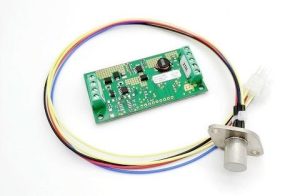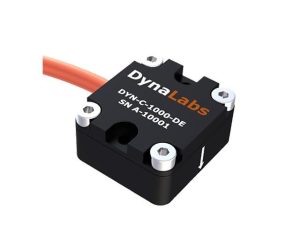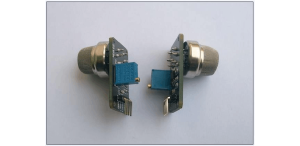Summary
Tilt sensors, critical in detecting orientation and inclination, are pivotal in modern technology. This blog explores different types of tilt sensors, such as electrolytic, capacitive, and MEMS, each with unique specifications suited to various applications. From ensuring the stability of smartphones and gaming consoles to enhancing safety in industrial machinery and medical devices, tilt sensors are indispensable. Discover how these tiny yet powerful components contribute to our daily lives and the advanced technology around us. Explore the fascinating world of tilt sensors and their remarkable applications!
Introduzione
Have you ever marveled at the sheer power of a fighter jet performing a breathtaking barrel roll? Or the impressive sight of a massive crane effortlessly moving huge loads across a construction site?
Behind such seemingly effortless feats lies an unsung hero: the tilt sensor. These ingenious devices play a crucial role in a vast array of applications, from enabling daring aerobatic stunts to ensuring the stability of skyscrapers under construction. Despite their ubiquitous presence and importance, tilt sensors often go unnoticed, working quietly to provide critical data on inclination that keeps our world functioning smoothly.

Understanding Tilt Sensors
Tilt sensors are essentially transducers that measure the angle of tilt or inclination relative to a plane, usually the vertical or horizontal axis. It might sound simple, but the technology behind these sensors is remarkably sophisticated.
The real genius of tilt sensors lies in the variety of technologies they employ to detect shifts in orientation. Using mechanisms ranging from rolling balls to suspended masses, tilt sensors generate an electrical signal proportional to the tilt. This signal is then processed and used by various systems, enabling precise adjustments and real-time monitoring of tilt. It’s like having a tiny electronic spirit level constantly monitoring the position of the world.
Types of Tilt Sensors
Exploring the Diverse Technologies
Prepare yourself for an exploration of the incredibly diverse and exciting world of tilt sensors. From rugged, heavy-duty sensors used in aircraft to tiny gadgets in consumer electronics, each type of tilt sensor has its own strengths and weaknesses, catering to the varied needs of different applications.
Force Balance Sensors: The Gravity-Defying Workhorses
Let’s begin with one of the most reliable types in the tilt sensing industry: Force balance sensors, also known as gravity-referenced sensors.
These devices are designed to deliver high-precision DC accelerometers, making them ideal for applications such as maritime, aviation, and seismic monitoring.
Imagine a sensor so robust and reliable that it can endure the harshest conditions, from scorching deserts to icy tundras, while maintaining its impeccable accuracy. This is the hallmark of the force balance sensor.
With their wide measurement range and high precision, these sensors can detect even the subtlest inclinations, ensuring that your aircraft stays on course and your offshore equipment remains level, regardless of Mother Nature’s challenges.
MEMS Sensors: The Miniature Marvels of Tilt Detection
In the realm of miniaturization, MEMS (Micro-Electro-Mechanical Systems) tilt sensors reign supreme.
These tiny wonders, often smaller than a human hair, operate like futuristic ants—packing an incredible amount of power and precision into their miniature frames. Using movable proof plates and mechanical suspension systems, MEMS sensors detect the tiniest shifts in orientation, making them perfect for medical devices, consumer electronics, and aerospace applications.
Imagine your smartphone effortlessly switching its display orientation as you tilt it, or a surgical robot maintaining precise positioning during a delicate operation. This is the power of MEMS tilt sensors in action.
Fluid-Filled Sensors: The Electrolytic and Capacitive Wonders
For applications requiring exceptional accuracy and sensitivity, fluid-filled tilt sensors offer a unique and innovative solution.
These sensors can be further classified into capacitive and electrolytic types, each with distinct operating principles and capabilities.
Electrolytic sensors rely on fluid imbalance between electrodes to measure inclination, much like a tiny liquid-filled spirit level that constantly adjusts with the slightest tilt. Capacitive sensors, on the other hand, detect changes in capacitance caused by the movement of a central mass, akin to having a tiny gravitational sensor inside your device.
Both types excel in precision and industrial automation, providing top-notch tilt measurements across diverse settings. Whether you’re calibrating sensitive research instruments or ensuring the precise positioning of robotic arms in an assembly line, fluid-filled tilt sensors have you covered.

Specifications
Decoding the Critical Parameters
Choosing the right tilt sensor can feel like navigating a maze of technical terms and specifications. Don’t worry—we’re here to guide you through with precision and a touch of humor to keep you entertained.
Number of Axes: Choosing the Right Dimensionality
One of the key factors in selecting tilt sensors is the number of axes required for your application. Think of it like choosing the right pair of glasses. You wouldn’t want a single-axis lens when you need to see the world in its multi-dimensional splendor, would you?
Single-axis sensors monitor inclination on one plane, akin to a seesaw’s delicate ups and downs. Dual-axis and tri-axis sensors, on the other hand, provide comprehensive coverage over two and three axes respectively, ideal for tasks requiring a broader perspective of the tilt landscape.
Resolution and Measuring Range
Resolution and measurement range are the yin and yang of tilt sensor specifications, two forces that must be carefully balanced for perfect harmony (and accurate measurements, of course).
Resolution is the smallest change in inclination that can be detected, akin to the sensitivity of a finely tuned seismograph. Measurement range, however, is the span of angles the sensor can accurately measure, similar to the boundaries of a sports field beyond which all bets are off.
Striking the right balance between these parameters is crucial to ensure reliable performance and avoid measurement errors. High resolution without a sufficient measurement range is like using a high-powered telescope on a small patch of sky—you’ll miss the bigger picture. Conversely, a wide measurement range with poor resolution is like reading fine print with binoculars—struggling to see the tiny details.
Sensitivity, Noise Tolerance, and Output
Just when you thought we had covered everything, there are three more crucial specifications to consider: sensitivity, noise tolerance, and output type.
Sensitivity is the sensor’s ability to detect and respond to slight changes in inclination, akin to an ear finely tuned to the faintest whispers of tilt. Noise tolerance, on the other hand, ensures accurate measurements even in the presence of external disturbances—because we all know the world can be noisy.
Then there’s the output type, either digital or analog, which affects integration with other systems and the extent of signal processing required. It’s like choosing between a smooth, continuous stream of analog sound or a crisp, clear digital representation—each with its own pros and cons.

Applications
Enabling Innovation Across Industries
Having explored the inner workings and specifications of tilt sensors, let’s dive into the myriad applications where these unassuming devices shine.
From keeping our skies safe and stable to enabling precise positioning and movement in robotics, tilt sensors are the invisible heroes driving innovation across numerous industries.
Aerospace and Aviation
In the high-stakes world of aerospace and aviation, tilt sensors play a critical role in flight control systems and aircraft stabilization mechanisms.
Imagine a pilot executing a stomach-churning barrel roll, the aircraft twisting and turning through the sky with breathtaking precision. Behind the scenes, a suite of tilt sensors ensures each maneuver is executed with pinpoint accuracy, keeping the pilot (and lunch) firmly in control.
But it’s not just thrill-seekers who benefit from these clever devices. Commercial airlines use tilt sensors to navigate turbulent conditions and ensure smooth, stable flights—because no one wants their in-flight beverage ending up in their lap.
Robotics and Automation: Enabling Precise Positioning and Movement
In the realm of robotics and automation, tilt sensors are crucial for achieving precise positioning and movement.
From industrial robots on assembly lines to autonomous vehicles and even humanoid robots, these sensors are the unsung heroes ensuring our machines operate with unparalleled accuracy.
Imagine a robotic arm seamlessly assembling intricate machinery, its movements guided by precise inclination data from tilt sensors. With real-time orientation tracking, automated systems can adapt and adjust to their environment, ensuring every component is perfectly placed and every motion executed flawlessly.
The technology extends beyond factories. Picture a self-driving car navigating a mountainous road, its tilt sensors continuously monitoring the vehicle’s orientation and relaying data to controllers for precise steering adjustments, maintaining stability on the most treacherous terrains.
Construction and Heavy Machinery: Ensuring Stability and Safety
In the rugged world of construction sites and mining operations, tilt sensors play a vital role in ensuring the stability and safety of heavy machinery.
Integrated into equipment like excavators, cranes, and off-road vehicles, these sensors act as guardians, continuously monitoring angles to prevent rollovers and other hazardous incidents.
Imagine a massive crane gracefully maneuvering heavy loads with the finesse of a ballet dancer, every move dictated by the vigilant eye of a tilt sensor. Or picture a giant excavator perched on a steep incline, its tilt sensors providing critical data to maintain balance and avoid a catastrophic tipping accident.
In high-risk environments where safety is paramount, tilt sensors are the unsung sentinels, tirelessly safeguarding workers and ensuring the smooth execution of even the most challenging construction projects.
Consumer Electronics and Gaming: Enhancing User Experiences
While tilt sensors might seem the domain of industrial applications and high-stakes scenarios, these versatile devices have infiltrated our daily lives, transforming how we interact with consumer electronics and gaming.
Think back to the last time you tilted your phone to rotate the screen or played a motion-controlled game, seamlessly guiding your on-screen character with subtle controller movements. Behind the scenes, tilt sensors were hard at work, translating your intuitive gestures into precise inputs, making your device an extension of your mind and body.
But the possibilities don’t end there. Virtual reality headsets, augmented reality applications, and fitness trackers all rely on tilt sensing technology to deliver immersive experiences and accurate motion tracking. It’s like having an orientation guide
continuously monitoring and adapting to every tilt and turn.
Other Applications: From Human Movement Studies to Thermostats
Just when you thought the applications of tilt sensors couldn’t get any more varied, we delve into the realms of human movement studies and thermostat design, among others.
In biomechanics and rehabilitation, wearable tilt sensors provide valuable insights into gait, posture, and overall body mechanics. Imagine tiny electronic coaches continuously monitoring your movements and offering data-driven feedback to help you improve performance or recover from injuries.
Even something as simple as a thermostat can benefit from the precision of tilt sensors. By accounting for the device’s angle, these little helpers ensure accurate temperature control, preventing costly overcooling or overheating scenarios.
From the depths of the ocean to the vast expanse of space, tilt sensors have proven their worth time and again, constantly pushing the boundaries of what’s possible and enabling technologies previously thought unattainable.
Conclusione
As we stand on the brink of a technological revolution, the future of tilt sensing technology is brimming with potential, poised to shape and transform the world around us in ways we can scarcely imagine.
Advances in MEMS technology and miniaturization are paving the way for smaller, more efficient, and more robust tilt sensors, allowing their integration into an ever-expanding array of applications and devices. Imagine fabrics that can detect and adapt to every movement or tiny medical devices that monitor and correct bodily imbalances with pinpoint accuracy.
However, the real game-changer lies in the advent of machine learning and artificial intelligence algorithms. By harnessing the vast amounts of data generated by tilt sensors, advanced systems will be able to learn, adapt, and even predict patterns of inclination, unlocking new realms of possibilities in areas like predictive maintenance, autonomous navigation, and more.
The journey of tilt sensors from their humble beginnings to their current sophisticated forms is a testament to human ingenuity and the relentless pursuit of innovation. As these small yet mighty devices continue to evolve, their impact on technology and everyday life will only grow, driving progress and opening up new frontiers of possibility.
So next time you marvel at an aerobatic stunt, watch a towering crane in action, or simply tilt your smartphone, take a moment to appreciate the incredible technology working behind the scenes. The world of tilt sensors is not just fascinating; it’s a cornerstone of modern innovation, quietly making our lives safer, more efficient, and more connected.
If you want to buy this product, please contact us.
